story and photos by Kayte Deioma
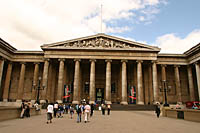 French, American and English teams have done most of the archaeological excavation in Egypt. They each brought home a wealth of treasures which found homes in the Louvre, the Metropolitan Museum of Art and the British Museum. Despite a fascination with ancient Egypt, it was not the mummies that brought me to the British Museum. It was the Celts and the Anglo Saxons. You won’t find many of their ancient arts at the Louvre or the Met. The Brits keep their ancestral artifacts close to home. This is why, despite my penchant for less common pursuits on a rainy day, I happily joined the crowds of school children and tourists descending on the British Museum. I wanted to see what the Celtic half of my ancestors had been up to a couple millennia ago.
French, American and English teams have done most of the archaeological excavation in Egypt. They each brought home a wealth of treasures which found homes in the Louvre, the Metropolitan Museum of Art and the British Museum. Despite a fascination with ancient Egypt, it was not the mummies that brought me to the British Museum. It was the Celts and the Anglo Saxons. You won’t find many of their ancient arts at the Louvre or the Met. The Brits keep their ancestral artifacts close to home. This is why, despite my penchant for less common pursuits on a rainy day, I happily joined the crowds of school children and tourists descending on the British Museum. I wanted to see what the Celtic half of my ancestors had been up to a couple millennia ago.
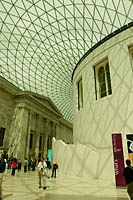 The building which houses the British Museum has gone through a variety of incarnations. The main entrance is through the Greek Revival South Front. This is part of a quadrangle of buildings completed in the mid-1850’s. After this expansion, they were still short of space, so they built a glass dome over the courtyard with the circular Reading Room at its center. It’s a unique space with the colonnades of the old buildings now making up the interior walls of the Great Court, surrounding the multi-level Reading Room.
The building which houses the British Museum has gone through a variety of incarnations. The main entrance is through the Greek Revival South Front. This is part of a quadrangle of buildings completed in the mid-1850’s. After this expansion, they were still short of space, so they built a glass dome over the courtyard with the circular Reading Room at its center. It’s a unique space with the colonnades of the old buildings now making up the interior walls of the Great Court, surrounding the multi-level Reading Room.
In addition to the best collection of British artifacts and the largest Egypt collection outside of Cairo, the British museum has an extensive Greek and Roman collection and a smattering of the rest of the world. I headed upstairs to the East Wing in search of my Celtic roots, leaving the Roman roots for another visit.
There is an interesting collection of swords and shields that have been 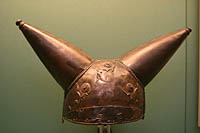 dredged up from the Thames and other river beds in Great Britain, where they had been deliberately deposited over a millennium in some form of water ritual. A circular bronze shield from 1200 to 1000 BC was found in the River Thames in London. The Chertsey Shield from 400-200 BC was dug up from a channel of the Thames in Surrey in 1985. A horned Iron-Age helmet from 150-50 BC, also found in the Thames, is the only one of its kind found anywhere in Europe.
dredged up from the Thames and other river beds in Great Britain, where they had been deliberately deposited over a millennium in some form of water ritual. A circular bronze shield from 1200 to 1000 BC was found in the River Thames in London. The Chertsey Shield from 400-200 BC was dug up from a channel of the Thames in Surrey in 1985. A horned Iron-Age helmet from 150-50 BC, also found in the Thames, is the only one of its kind found anywhere in Europe.
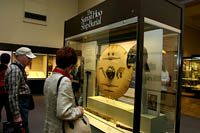 One of my favorite displays is a collection of artifacts from a burial ship found at Sutton Hoo in Suffolk. A king from the early 7 th century was buried in a 30-meter-long (97 feet) ship. They’re not sure which Anglo-Saxon king he was, but he was buried with his sword, shield, helmet, piles of clothes, barrels of food, a great cauldron to cook it in, and an impressive collection of Merovingian coins (from what’s now Belgium) dated from the early 600’s.
One of my favorite displays is a collection of artifacts from a burial ship found at Sutton Hoo in Suffolk. A king from the early 7 th century was buried in a 30-meter-long (97 feet) ship. They’re not sure which Anglo-Saxon king he was, but he was buried with his sword, shield, helmet, piles of clothes, barrels of food, a great cauldron to cook it in, and an impressive collection of Merovingian coins (from what’s now Belgium) dated from the early 600’s.
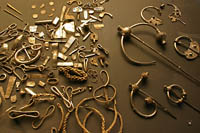 Most of the artifacts from Ireland are from the Viking period around the turn of the first millennium. Most of the Celtic items – brooches, pins and a few statues and pots – are from other parts of Europe.
Most of the artifacts from Ireland are from the Viking period around the turn of the first millennium. Most of the Celtic items – brooches, pins and a few statues and pots – are from other parts of Europe.
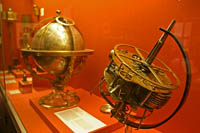 If you follow the numbered floor plan in the British wing, you go from the 7 th century through medieval times to the 19 th century and end up in the Bronze Age. I found that a bit confusing. The room on the development of the clock is kind of fun with some amazingly ornate chronometers.
If you follow the numbered floor plan in the British wing, you go from the 7 th century through medieval times to the 19 th century and end up in the Bronze Age. I found that a bit confusing. The room on the development of the clock is kind of fun with some amazingly ornate chronometers.
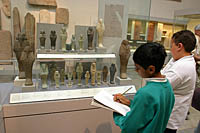 My partner in time gave me the half-hour warning, so I decided I should make a quick visit to Egypt after all. The Egyptian exhibit is on two floors. From Bronze Age Britain, I kept going north through the Ancient Near East to the Ancient Egypt exhibit along the whole north wing of the building. I rushed through the first few rooms of children sketching miniature sarcophagi and headed for the Funerary Archaeology display.
My partner in time gave me the half-hour warning, so I decided I should make a quick visit to Egypt after all. The Egyptian exhibit is on two floors. From Bronze Age Britain, I kept going north through the Ancient Near East to the Ancient Egypt exhibit along the whole north wing of the building. I rushed through the first few rooms of children sketching miniature sarcophagi and headed for the Funerary Archaeology display.
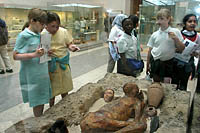 A group of kids was clustered around the reconstructed grave pit of the desiccated body of a Predynastic Egyptian Man. He had the unlikely name of Ginger, and his neighbor, the skeleton, Bones. I glanced at the questionnaire the boy next to me was filling out. “Have the skin and flesh survived?” He checked off Ginger’s box for Yes. Indeed, some hair and fingernails too. Gruesome, but fascinating.
A group of kids was clustered around the reconstructed grave pit of the desiccated body of a Predynastic Egyptian Man. He had the unlikely name of Ginger, and his neighbor, the skeleton, Bones. I glanced at the questionnaire the boy next to me was filling out. “Have the skin and flesh survived?” He checked off Ginger’s box for Yes. Indeed, some hair and fingernails too. Gruesome, but fascinating.
I moved along to the end of the hall and down the stairs, letting my eyes scan the feast of statuary as I made my way quickly through the Egyptian Sculpture rooms along the inner corridor of the west wing. I paused – not nearly long enough – to take in the Rosetta Stone, the translation key in three ancient scripts that unlocked the language of Egyptian hieroglyphics for modern scholars. It’s more than I can grasp in my remaining 60 seconds until lunch. A reason to come back another rainy day.
Admission to the permanent exhibits is free. There may be a charge for temporary exhibits. The British Museum galleries are open Saturday – Wednesday 10 a.m. to 5:30 p.m.; Thursday and Friday 10 a.m. to 8:30 p.m. The Library and Information Centre are open daily 10 a.m. to 5:30 p.m. The Reading Room, Great Court, Bookstore and Restaurant all have different openhours. Visit the British Museum web site at www.thebritishmuseum.ac.uk for additional information. The web site has a searchable database called Compass of over 5,000 items from their collections. There is also a special interactive Children’s Compass with online tours and explanations written especially for children.

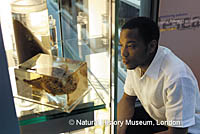 The Darwin Centre was built as an adjunct to the Natural History Museum to house and give access to the 22 million specimens collected and received by the NHM. Although it is part of the museum, the Darwin Centre’s main focus is research (when we were there last week, scientists were completing a 3 year study of the effects on marine life in the Gulf after the first Gulf War).
The Darwin Centre was built as an adjunct to the Natural History Museum to house and give access to the 22 million specimens collected and received by the NHM. Although it is part of the museum, the Darwin Centre’s main focus is research (when we were there last week, scientists were completing a 3 year study of the effects on marine life in the Gulf after the first Gulf War).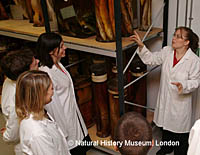 It is imperative to book a tour. It is possible to do this on-site and maybe get a tour later in the day, but this will be more difficult to do during public and school holidays. Tours last about 30 minutes and are guided by a member of the research staff. You will be asked to store in a locked locker any bags or lose articles of clothing and will be given a lab coat to wear. The guides are knowledgeable and willing to answer questions.
It is imperative to book a tour. It is possible to do this on-site and maybe get a tour later in the day, but this will be more difficult to do during public and school holidays. Tours last about 30 minutes and are guided by a member of the research staff. You will be asked to store in a locked locker any bags or lose articles of clothing and will be given a lab coat to wear. The guides are knowledgeable and willing to answer questions.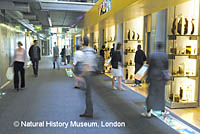 There are 27 kilometres of shelves ranged over 6 floors in the Darwin Centre as well as a large number of large metal storage containers in the basement. The specimens come from as long ago as the 1750s right up to today. All are stored in glass jars that need to be topped up regularly with alcohol to ensure their continued existence. You will not, of course, see them all; the guides pick an area and show some specimens from that section.
There are 27 kilometres of shelves ranged over 6 floors in the Darwin Centre as well as a large number of large metal storage containers in the basement. The specimens come from as long ago as the 1750s right up to today. All are stored in glass jars that need to be topped up regularly with alcohol to ensure their continued existence. You will not, of course, see them all; the guides pick an area and show some specimens from that section.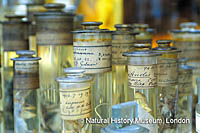 While children tend to be the ones we think of when we go to museums of this kind, I found it at least as interesting as my children did. The Darwin Centre has plans to extend the facilities by 2008 and add another building which will house their insects and larger mammals.
While children tend to be the ones we think of when we go to museums of this kind, I found it at least as interesting as my children did. The Darwin Centre has plans to extend the facilities by 2008 and add another building which will house their insects and larger mammals.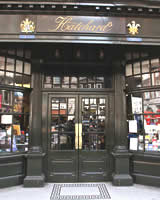 When I have some time on my own, I tend to make my way to a bookshop. Not only are they usually warm, dry and usually not too crowded, but they offer a certain comfort that you don’t often get from other kinds of shops. Of course there is always a Waterstone’s – the huge, find-every-book-that-you-could-dream-of-wanting bookshop. There’s one in Picadilly, just off Picadilly Circus. But there is another very special bookshop just down the street, which, despite being owned by Waterstone’s has retained its olde worlde charm. Hatchard’s, at 187 Picadilly, comes by its charm honestly from being open since 1782. They have been offering the reader or browser a wonderful selection of books for over 200 years.
When I have some time on my own, I tend to make my way to a bookshop. Not only are they usually warm, dry and usually not too crowded, but they offer a certain comfort that you don’t often get from other kinds of shops. Of course there is always a Waterstone’s – the huge, find-every-book-that-you-could-dream-of-wanting bookshop. There’s one in Picadilly, just off Picadilly Circus. But there is another very special bookshop just down the street, which, despite being owned by Waterstone’s has retained its olde worlde charm. Hatchard’s, at 187 Picadilly, comes by its charm honestly from being open since 1782. They have been offering the reader or browser a wonderful selection of books for over 200 years.